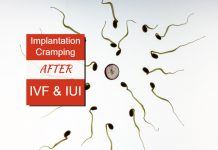How heavy is implantation bleeding? Implantation bleeding is not heavy and doesn’t have clots. Movement of egg dissolving parts of uterine wall releases little blood drops. Spotting from implantation is brown as the blood takes a long time to trickle down.
Implantation bleeding is light spotting of light brown or pinkish color because of egg embedment.
Any mid-cycle bleeding that gets heavy or was normal flow is not implantation spotting. ‘Can implantation bleeding be heavy?’ is a question asked by women who have mid-cycle bleeding and are not able to understand why.
The term implantation bleeding refers to the phenomenon that happens at the cellular level. When the egg embedment occurs the capillaries of blood leak due to puncture by a 64 celled structure called blastocyst.
But we cannot see it, and for us, it only comes out of the vagina as brown spotting or discharge mixed with mucus.
Implantation discharge doesn’t get heavy and lasts for a very brief period. Only one-third of pregnant women experience this while it is ongoing. Most of them an entirely it later when they take a pregnancy test because they see signs of pregnancy in them.
How heavy is implantation bleeding?
Implantation bleeding is never heavy in ordinary cases. A small ball of cells is not capable of causing a heavy flow. When a woman is ovulating, she has similar symptoms and experiences spotting rarely.
Just like that release of blood, during implantation, there is merely spotting. It is not compulsory that a woman will have implantation bleeding but implantation will still be successful.
Later on, when she takes a pregnancy test, she will come to know about it. A heavy flow of blood is period, and it has a similar timing as implantation. Implantation can occur between 7-12 days, and this makes it possible for happening two days before period.
Period dates fluctuate and you might have an early onset which you desperately want to believe is implantation bleeding.
After conception, the zygote divides and moves down the tubes to attach in the uterus. When it implants in the uterus, the trophoblast or egg membrane immerse in the endometrial lining.
It causes a bend creating in the upper layer, and it starts bleeding. It is like a needle pricking a bag of blood. The hole is so small that only a tiny amount of blood escapes before the clotting completes at the puncture.
Period flow has similar symptoms like cramping and bleeding. But a woman with a regular cycle can realize that there is a change of date drastically. Also, the intensity of symptoms of implantation and period are chalk and cheese.

Physical characteristics of a bloody discharge
The bloody discharge during egg embedment is few drops of blood. It is old blood and so has a brown tinge. Implantation bleeding doesn’t have any harsh symptoms like spasms and cramps along. There are no clots in the blood.
During the period the endometrial lining disintegrates and causes the release of the lining of the uterus.
The blood vessels and other parts come out as clots. You can see them on your pad. You soak many pads during period and more on the second or first day.
But implantation won’t even need a liner or at most one. If you are soaking pads quickly, then you are not having implantation bleeding.
Heavy implantation bleeding is a sign that you may be having a tubal pregnancy. Due to blockages and abnormalities, the blastocyst will not be able to move down the tubes. After fertilization, the egg divides to form a mulberry structure of cells.
It further divides to form a 64 celled structure called blastocyst for implantation in the uterus. Until then the embryo is developing in the tubes. After the divisions are complete the embryo implants in the wall of the uterus.
Now the growth and development of baby start by the formation of precursors of organ systems. The placenta formation starts with two precursors chorion and amnion.
How heavy can implantation bleeding be?
There is no limit to implantation bleeding if you consider all aspects. In case you have an ectopic pregnancy then the bleeding can be as heavy as a period.
Under normal cases, the implantation bleeding will not be more substantial than few drops.
Implantation spotting is light and short term. It gets over soon and doesn’t cause much pain.
If your tubes have blockages, then the implantation will occur in the upper parts. It will cause them to expand beyond the normal range. The cramping will get worse and painful. As the embryo will keep growing the implantation bleeding will be heavy.
Once you feel that the implantation symptoms are aggravating, you must tell your doctor. After the checkup, you can take early non-invasive treatments for it. At a later stage, you will have to undergo a surgical procedure that may even require removal of ovary and tube.
Miscarriages also happen at a very early stage before implantation. Many pregnancies undergo an implantation failure to bleed like a miscarriage.
A miscarriage bleeding is heavy and lasts for ten days. Chemical pregnancy also has a similar fate.
Initially it behaves like a healthy pregnancy, and later on, it starts bleeding. Women who are pregnant can have a breakout bleeding at the time they expect their period. So the heavy bleeding can be breakout bleeding.
Can implantation bleeding be heavy?
Implantation bleeding heavy is an entirely wrong term for everyday use. First of implantation doesn’t even cause bleeding and it only leads to spotting.
Heavy implantation bleeding is the most inappropriate adjective for the term, and that is the cause of confusion.
If women knew for sure that implantation bleeding is only light spotting, then it would be easy to distinguish implantation bleeding or period.
Implantation bleeding can be heavy if you do not have normal implantation.
In all other cases, implantation discharge will be a few milliliters of blood.
Symptoms along implantation
There are symptoms of implantation which are lesser known. Most women don’t experience implantation and so never remember what they felt at that time. Others are not sure whether they are implantation cramps or PMS cramps.
There are ten symptoms of implantation that generally don’t happen in other cases during mid-cycle bleeding:
1) Implantation cramps
They are mild cramps which feel like tingling sensations and a light downward pull.
2) Implantation dip in BBT
The basal body temperature in pregnant women takes a dip after ovulation rise. Later on, it returns to normal. This is a triphasic pattern of BBT during implantation.
3) Implantation bleeding
Spotting mid-cycle along with mild cramps and a fall in BBT is a sign of implantation.
4) Fatigue and heavy headedness
During PMS you feel hyper, while implantation shifts you to a limited activity phase.
5) Bloating
There is bloating near your abdomen because implantation leads to the release of hormones that dilate the uterus.
6) Increases cervical mucus
As progesterone levels and other pregnancy hormones start rising the mucus production accelerates. It is for forming a protective mucus plug.
How to determine if it is period blood?
The most frequently asked question about implantation is how to decide implantation bleeding or period. There are factors that can help you differentiate between the two by considering those criteria.
1) The timing of bloody discharge
Implantation bleeding happens after few days from ovulation. While period takes a fortnight after ovulation to start. It is for the lining to disintegrate to be able to slough off. When you have spotting near ovulation date, then it is less likely to be period. After ovulation, the menstrual cycle goes to the luteal phase during which they cyst secretes a lot of progesterone.
2) Duration of bleeding
Periods last for three to five days generally for most women. Some women might have a week-long period. But implantation bleeding is more likely to end by the end of the day. Under normal conditions implantation, bleeding will not continue after two days.
3) Color of spotting
Implantation bleeding is mostly brown or pinkish. It is because the blood stayed in the vagina for long and then comes out. A period is like fresh, bright red blood from a cut. Implantation bleeding doesn’t look like menses at all and is not bright red. There are no clots in implantation bleeding.
Risk of heavy implantation bleeding
Heavy implantation bleeding can lead to extreme blood loss that causes fainting. The result of tubal pregnancy can be a reduction in fertility by a major percentage.
Implantation bleeding gets heavy as a result of an abnormality. Risks associated with tubal pregnancy are fatal.
Heavy implantation bleeding needs medical attention and cannot go without treatment. The longer it continues, the more potent it is for damage.
Treatment for heavy implantation bleeding
The treatment for heavy bleeding due to implantation is for the cause. Methotrexate flooding is a treatment option for tubal pregnancy.
Surgical procedures remove the parts or embryo and other remnants. There is nothing you can do at home without the help of a doctor. You should lie down and avoid taking any physical stress.
Call your doctor and let out the symptoms and sequence of events from starting. Also, make sure you have your blood group tested.
If it is a threatened miscarriage, then doctors might be able to save your pregnancy because in that condition the implantation was normal.




![Implantation Bleeding With Twins [How long does IB last with twins?] Implantation Bleeding With Twins](https://www.pregnanteve.com/wp-content/uploads/2019/01/implantation-bleeding-with-twins-218x150.jpg)





Comment:I had my period today when is my ovulation period? please help me
About 14 days after period ends